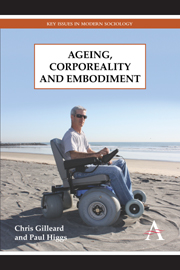Book contents
- Frontmatter
- Contents
- Introduction
- Chapter 1 Identity, Embodiment and the Somatic Turn in the Social Sciences
- Chapter 2 Corporeality, Embodiment and the ‘New Ageing’
- Chapter 3 Gender, Ageing and Embodiment
- Chapter 4 Age and the Racialised Body
- Chapter 5 Disability, Ageing and Identity
- Chapter 6 Sexuality, Ageing and Identity
- Chapter 7 Sex and Ageing
- Chapter 8 Cosmetics, Clothing and Fashionable Ageing
- Chapter 9 Fitness, Exercise and the Ageing Body
- Chapter 10 Ageing and Aspirational Medicine
- Conclusions: Ageing, Forever Embodied
- References
- Index
- ADVANCE PRAISE
Chapter 4 - Age and the Racialised Body
Published online by Cambridge University Press: 05 July 2013
- Frontmatter
- Contents
- Introduction
- Chapter 1 Identity, Embodiment and the Somatic Turn in the Social Sciences
- Chapter 2 Corporeality, Embodiment and the ‘New Ageing’
- Chapter 3 Gender, Ageing and Embodiment
- Chapter 4 Age and the Racialised Body
- Chapter 5 Disability, Ageing and Identity
- Chapter 6 Sexuality, Ageing and Identity
- Chapter 7 Sex and Ageing
- Chapter 8 Cosmetics, Clothing and Fashionable Ageing
- Chapter 9 Fitness, Exercise and the Ageing Body
- Chapter 10 Ageing and Aspirational Medicine
- Conclusions: Ageing, Forever Embodied
- References
- Index
- ADVANCE PRAISE
Summary
In the previous chapter we argued that men and women's ageing made salient different aspects of an aged identity. Furthermore we argued that this could give rise to different ways of ‘performing’ age while maintaining a still gendered identity in later life. Part of performing gender in later life we suggested meant not acceding to the ‘neutralising’ corporeality of old age. This then opens up the possibility that if it is possible to retain in later life the distinctions of gender without necessarily embodying its past oppressions, might a similar situation apply to racialised identities? Putting it slightly differently, might retaining a racialised identity through later life be another way of not becoming old? Or does ageing ‘in culture’ serve merely as a revisiting of past oppressions with present ones - leading only to a different and potentially more debilitating way of becoming old? In this chapter we address the historical forms by which race has been embodied in people's lives and its contemporary significance for understanding and interpreting ageing without becoming old.
At this juncture it is important for us to be clear how the term ‘race’ is being used before we consider how race has been used in studying ageing. Without bodies race has no social signification, and without social institutions and practices race has no bodily identity. In this chapter we will concentrate primarily upon skin colour as the site for the embodied distinction between ‘black’ and ‘white’ and use the term racialisation to indicate the imbrication of social relations by this ‘black/white’ skin colour divide.
- Type
- Chapter
- Information
- Ageing, Corporeality and Embodiment , pp. 51 - 68Publisher: Anthem PressPrint publication year: 2013



